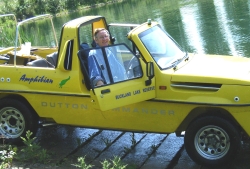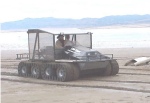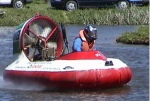About the Museum
 The collection represents the long term aspiration of Doug Hilton from the UK. Doug has been fascinated by and associated with boats, aeroplanes and items of mechanical novelty for most of his life. His across the three elements creative interest having been captivated in the 1960's when paddling a home made canoe and seeing an 'Amphicar' take to the water. It was amazing - it floated.
The collection represents the long term aspiration of Doug Hilton from the UK. Doug has been fascinated by and associated with boats, aeroplanes and items of mechanical novelty for most of his life. His across the three elements creative interest having been captivated in the 1960's when paddling a home made canoe and seeing an 'Amphicar' take to the water. It was amazing - it floated.
He takes a great interest in people, what motivates them and the how and the why of the way they do things. He is director of several companies specialising in industrial property and wildlife conservation and has a lifetimes experience of the construction industry.
Whilst embracing modern high technology and public safety protection standards, he fears that the inspirational 'can do' and 'go for it' attitudes as represented by most of the creators of the 'Land Air and Sea' exhibits, are slowly being taken away from today's youth by standardised educational systems, public safety obsessions and the media, which often over emphasize the dangers concerned with any form of risk or of daring to be different from the rest of the crowd.
Taking risks (considered ones), having a go, doing your own thing and permitting yourself to have creative dreams in the first place and then following them, is what youth has been genetically programmed to do over millions of years. Remove this and you strike at the fundamental sense of individual personality and potentially remove any ability to creatively think at all. The potential result could be a society of uncreative, boring people who think and do only what they are told.
It is our responsibility for future generations to understand that all systems, however well meaning, need a check balance if we feel they may be going too far. We believe that an exhibition like ours can help put people back in touch with a sense of the raw challenge, the risks, adventure, excitement, dreams, skills, hard slog and sense of tremendous pride and personal achievement of the creators. We wish to help future generations be safe, be careful, be skilled at what they do - but also to keep alive or relearn the art of how to lead vibrant, creative, inspirational and fulfilling lives.
Multi Role Vehicles
Multi-role vehicles generally require the incorporation of design features that are completely at odds with each other. An aeroplane for instance needs to be a light as possible, to be driven by a jet or propeller and possess a whole range of balancing and aerodynamic surfaces such as wings and extended tail planes that cars simply don't have. Whereas in a car, more weight can be an important safety factor and wings and tails would mean they could not get into the garage, let alone along the road! Boats need long clean lines on the hull, no holes below the waterline and to be reasonably lightweight. Cars however have short flat bottoms and wheels on each corner causing massive drag, lots of holes and opening doors to let the water in!
How do inventors get around these apparently irreconcilable issues? We can assure you, that by no means do they all go about it in the same way and in that lies the challenge, the fun and the creativity.
Come and see in this website and its links page, how many ways they have tried.
Flying Cars
Can't be done - can it? - It certainly can, has been and with modern technology it has had a big revival.
Of these incredible feats of engineering, more than one hundred patents exist although few flying cars until recently have ever reached the mock up stage, let alone flown. Most of these have been in the United States of America.
The ConvAirCar of the 1940's and the Taylor Aerocar of the 1950's being just two examples which flew thousands of hours in their time. Both had detachable tails and wings and either towed these behind on wheels or left them at the airport.
 Recent years have seen an amazing surge in an entirely new range of flying cars under development. Some use state of the art microprocessor controls such as Paul Moller's Skycar. Branko Sah'rs Aerocar 2000 is a hitch the car up to the aeroplane type and the latest Terrafuga with folding wings. Sadly we have to disappoint James Bond fans by revealing that his car never really flew; special film effects did it all.
Recent years have seen an amazing surge in an entirely new range of flying cars under development. Some use state of the art microprocessor controls such as Paul Moller's Skycar. Branko Sah'rs Aerocar 2000 is a hitch the car up to the aeroplane type and the latest Terrafuga with folding wings. Sadly we have to disappoint James Bond fans by revealing that his car never really flew; special film effects did it all.
Some of the flying car prototypes that actually flew also ultimately crashed, sometimes killing their creators. Some are in museums and others are still out there somewhere. Where?
We are seeking flying cars for the collection and need your help with any information that may lead us to one of these amazing but rare beasts. It may look crude or never have flown but we may well be interested - it is about how the attempt was made the matters.
Most leads for flying cars are from the USA - come on all you UK and European inventors - someone must have had a go at this sometime - we will be pleased to hear - even if it is just the story for our archives.
Flying Boats, Amphibious Aircraft
Catalina, Sunderland, Grumman and many other huge passenger flying boats were the evocative dream machines in which to visit the far flung and exotic places of the earth during the early part of last century. In those days, populations were not as large and normally based beside rivers, the sea or inland lakes. In many countries, there were few aircraft around and certainly few places that had enough passengers to bother with the incredible cost of making and maintaining runways; especially when pioneering a route. The answer was to use flying boats. By far the largest ever and possibly most famous single flying boat is the 'Spruce Goose'. This huge amphibian was flown only once (for about one minute) and was then put away for 33 years!
During the second world war, huge numbers of runways were built around the world for fighter aircraft and these were left behind, permitting faster wheeled passenger aircraft to take over the routes from the slow and inefficient flying boats.
There are still a few operational flying boats around today although they are not as large as in the past and they tend to be mostly used for island hopping and the like.
Smaller, ordinary light aviation aircraft fitted with floats to make them amphibious now dominate the amphibious aircraft class. Many are used for chasing the dream of visiting those hidden lakes in the hills and tucked away secret places and islands.
In recent years the growth of highly portable and cheaper microlight and ultralight aircraft has assisted in spreading the message of fun flying with water take off and landings using floats. This has given rise to many really strange shapes and profiles of floats as various creators struggle with efficiency, weight and aerodynamic drag.
We are currently seeking a small flying boat and floatplane for the collection and need your help to locate them! Please contact us if you know where we can obtain items suitable for our collection. Again, the greater the wow factor and thrill ability the better. This generally means older and more exciting rather than modern and smooth as a jelly mould.
Links to our flying boat friends
Submarines
Submarines are the product of countless individual and collective inventions. To create a surface and underwater vehicle to travel in this hostile environment where death is a rapid reward for error requires great courage and ingenuity, many have died trying.
In their creative inventiveness, mechanical novelty and dual role as underwater and surface ships, submarines fit admirably into our dual element collection.
 People often think of submarines as having to keep the crew dry, but many recreational submarines are not dry, their crew having to wear underwater suits and breathing apparatus. To not have to keep the crew dry can save huge complexity in submarine design and make it safer and more flexible under many circumstances, because you loose the risk of being trapped inside and are already wearing your escape suit! They are however limited to depths of around 30-40 metres otherwise problems for the crew with breathing and being crushed occur. You also have the ability on a wet submarine to have a look around a large area and then get out and examine things, which of course, in a dry submarine you could not do.
People often think of submarines as having to keep the crew dry, but many recreational submarines are not dry, their crew having to wear underwater suits and breathing apparatus. To not have to keep the crew dry can save huge complexity in submarine design and make it safer and more flexible under many circumstances, because you loose the risk of being trapped inside and are already wearing your escape suit! They are however limited to depths of around 30-40 metres otherwise problems for the crew with breathing and being crushed occur. You also have the ability on a wet submarine to have a look around a large area and then get out and examine things, which of course, in a dry submarine you could not do.
We are currently seeking small submarines for the collection and need your help to locate them! Please let us know if you have or know of an interesting special sub' that may fit into the collection. These should preferably be of an older type and have a wow factor when looking at them.
Historically important, or sub's with a great history of particular interest.
Links to our submarine friends
Amphibious Vehicles
These amazing vehicles have been designed in many different and fascinating ways to combat the most likely challenge the average person will meet. That of driving across rivers, through floods or over boggy terrain. It is hardly surprising then that the goal of producing unique, affordable amphibious vehicles has been the aim of many hundreds of 'have a go' and commercially minded inventors across the years.
The German 'father' of amphibians 'Hans Tripple' was creating amphibians from the early 1920's up until almost his death aged 92. This remarkable man was instrumental in the design of over 30 different amphibious vehicles, being particularly associated with the Schwimmwagen and the world famous Amphicar of the 1960's. Sadly, even after spending a lifetime and tens of millions of pounds he was unable produce the ideal mass production amphibian.
 It is amazing therefore that despite so much worldwide effort, creativity and money having been poured into this area, that it does not have more of a record of success. However, probably no amphibious car yet produced offers the full combination of comfort levels equivalent to a typical modern family car, lasting built in durability (especially important in salt water), four wheel drive and being able to be sold and maintained at a price fully affordable to most.
It is amazing therefore that despite so much worldwide effort, creativity and money having been poured into this area, that it does not have more of a record of success. However, probably no amphibious car yet produced offers the full combination of comfort levels equivalent to a typical modern family car, lasting built in durability (especially important in salt water), four wheel drive and being able to be sold and maintained at a price fully affordable to most.
As far as manufacturers of road legal, civil amphibious cars go, Tim Dutton from his UK factory seems to vary from being the only one in the world, to one of the few as others try and fail.
Many exciting high speed prototypes have recently been brought onto the design market using retractable wheels or hydrofoils in order to cut drag and achieve speeds of well over 30 miles per hour on water. Some of these however use complicated mechanical and computer systems that seldom result in long term reliability when subjected to the typical amphibious vehicle high humidity, salt water and low levels of use and where a 'keep it simple' approach is often best. They also often lack 4 wheel drive, which is a basic must for getting out of the water on anything but gently sloping hard slipways. And yet, nearly every vehicle has some unique point of design, fascinating function, or amazing story to tell. They are all just such great fun.
We need your help. We are looking for very special and unusual amphibious vehicles.
Please contact us know if you have any ideas.
Links to our amphibious friends
Larger Amphibians
There are and have been some absolutely huge amphibious transporters, cranes and passenger vessels. No collection would be complete without an example of the well known and much loved military DUCK (real initials DUKW). Most people have at some time or other had a trip on one or seen one operating from a seaside beach.
Links to our Amphibious friends
ATVs
 The sports side of amphibious vehicles is mainly dominated by what are known as 'all terrain vehicles' or ATV's for short. ATV's tend to be smaller, much cheaper and far simpler to produce than amphibious cars. Few are road legal. Most have either tracks or many revolving wheels to power them on the land and in the water rather than an engine driven propeller, they therefore tend to be slower than amphibious cars when afloat.
The sports side of amphibious vehicles is mainly dominated by what are known as 'all terrain vehicles' or ATV's for short. ATV's tend to be smaller, much cheaper and far simpler to produce than amphibious cars. Few are road legal. Most have either tracks or many revolving wheels to power them on the land and in the water rather than an engine driven propeller, they therefore tend to be slower than amphibious cars when afloat.
An amazing array of highly versatile if basic vehicles have been produced around the world and customised for many uses from crossing lakes, snow travel, agricultural uses, hunting, climbing mountains or for rescue and emergency services. They are in many ways the modern equivalent of the horse for many explorers.
We need your help. We are looking for very special and unusual ATVs to exhibit. These are unlikely to be of a standard production type unless heavily customised or with a great story to tell - perhaps from some groundbreaking expedition. Again, the more eye catching, crude and inspirational they look the better. Please contact us if you have any ideas.
Hovercraft
Hovercraft have an amazing range of uses and when operating on difficult terrain suited to them, they have no equal; being 'able to go where nothing else has gone before' (not even Starship Enterprise)!
Hovercraft are fantastic creatures, travelling over land and sea on a cushion of air -they can also float! Many people only think of hovercraft as large commercial or military craft but in fact there are large and fast growing sports hovercraft clubs in most countries, which hold regular events and competitions. The whole development of the hovercraft idea is that of creative invention and applied dreams, with many variations having been produced for different applications.
 They can tend to be noisy with fan noise and to use fair amounts of fuel.
They can tend to be noisy with fan noise and to use fair amounts of fuel.
The advent of fast catamaran hulled ferries drastically reduced the hovercraft role as high speed passenger and load carriers and therefore most commercial uses have ceased, other than for obtaining access where single element vehicles would not work. Small recreational hovercraft go from strength to strength however and there are now many thousands of these vehicles worldwide and the advent of offshore windfarms has also stimulated the commercial market.
Links to our Hovercraft friends
We are always looking for special and unusual amphibious vehicles, ATV's, hovercraft etc. We seek something either custom built with a great creative invention storey, something that has perhaps been used in a groundbreaking adventure etc. The more eye catching the better and we have no requirement for the exhibit to be highly sophisticated - just fascinating to look at with a great storey to tell contact us.